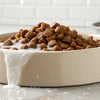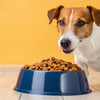How Much Dry Food Should a Dog Eat Per Day? A Comprehensive Guide for Pet Owners
- Houndsy
Table of Contents
- Introduction
- Factors That Determine How Much Dry Food to Feed Your Dog
- How to Determine the Right Amount of Dry Food
- The Importance of High-Quality Dog Food
- Feeding Frequency: How Often Should You Feed Your Dog?
- Signs of Overfeeding or Underfeeding
- Adjusting Food Intake as Your Dog Ages
- Conclusion
Introduction
As devoted pet owners, we all want the best for our furry companions. Did you know that approximately 59% of dogs in the United States are classified as overweight or obese? This alarming statistic highlights the importance of understanding how much dry food our dogs should eat each day. Feeding our pets the right amount of food is crucial to their health, energy levels, and overall well-being.
In this blog post, we will explore the various factors that influence your dog’s daily food intake, including age, size, activity level, and specific dietary needs. We'll provide practical guidance on how to determine the right portion sizes for your dog and discuss the significance of high-quality dog food, like the Houndsy Kibble Dispenser, which is designed to elevate the feeding experience. By the end of this article, you will have a thorough understanding of how much dry food your dog should eat per day and how to ensure they receive the nutrients they need to thrive.
As we delve into this topic, we encourage you to reflect on your own pet's feeding routine. Are you certain they're getting the right amount of food? Let’s embark on this journey to better understand our dogs’ nutritional needs together.
Factors That Determine How Much Dry Food to Feed Your Dog
Feeding our dogs isn’t a one-size-fits-all approach; there are several factors to consider when determining the right amount of dry food. Here are the key elements that influence your dog's dietary needs:
1. Age
Puppies: Young dogs require a lot more energy and nutrients to support their rapid growth. Puppies typically need to be fed more frequently and in larger quantities. As they grow, their caloric needs will change, so it’s essential to adjust their food intake accordingly.
Adult Dogs: Once dogs reach adulthood, their caloric needs stabilize. However, factors such as activity level and overall health will still play a role in their daily food requirements.
Senior Dogs: Older dogs often require fewer calories due to a decrease in activity level and metabolism. It's essential to monitor their weight and adjust their food intake accordingly.
2. Size and Breed
The size of your dog significantly impacts how much food they require. Generally, larger breeds need more food than smaller breeds. For instance, a Great Dane will require more calories than a Chihuahua. Additionally, some breeds are naturally more active than others, which can further influence their caloric needs.
3. Activity Level
An active dog will burn more calories and, therefore, require more food than a less active dog. If your dog participates in regular exercise or strenuous activities, they will need a higher caloric intake to maintain their energy levels.
4. Body Condition Score (BCS)
The BCS is a valuable tool for assessing your dog's weight and overall health. It helps to determine if your dog is underweight, at an ideal weight, or overweight. If your dog is overweight, they will require fewer calories, while underweight dogs need more food to reach a healthier weight.
5. Health Status
Any pre-existing health conditions can affect your dog's dietary requirements. For example, dogs with diabetes may need a special diet, while pregnant or nursing dogs require additional nutrients to support their puppies.
How to Determine the Right Amount of Dry Food
Now that we’ve established the factors that influence your dog’s food intake, let’s explore how to determine the right amount of dry food to feed them.
Feeding Guidelines
Most dog food manufacturers provide feeding guidelines based on weight, age, and activity level on the packaging. These guidelines are excellent starting points but often require adjustments based on your dog's unique needs.
Step-by-Step Process
- Check the Feeding Chart: Start by looking at the feeding chart on your dog’s food packaging. This chart typically provides a recommended daily amount based on your dog’s weight.
- Assess Your Dog’s Weight: Weigh your dog to determine their current weight. If your dog is overweight or underweight, you may need to adjust the recommended serving size by 10-20%.
- Consider Activity Level: If your dog is particularly active, you may want to increase their food intake slightly. Conversely, if they are less active, consider reducing the amount.
- Monitor Your Dog’s Body Condition: Regularly assess your dog’s body condition score. If they seem to be gaining or losing weight, adjust their food intake accordingly.
- Consult Your Veterinarian: If you’re unsure about how much food to feed your dog, consult your veterinarian for tailored advice based on your dog’s specific needs.
Example Feeding Guide
Here’s a general guideline for how much dry food to feed your dog, based on their weight:
- Small Dogs (2-20 lbs): 1/2 - 1 1/2 cups per day
- Medium Dogs (21-50 lbs): 1 1/2 - 2 1/2 cups per day
- Large Dogs (51-100 lbs): 2 1/2 - 4 cups per day
- Giant Dogs (over 100 lbs): 4 cups and up, depending on size and activity level
Remember, these amounts are just starting points, and you should adjust them based on your dog’s individual needs.
The Importance of High-Quality Dog Food
The type of dog food you choose also plays a crucial role in your dog’s overall health. High-quality dry food is formulated with balanced nutrients to meet your dog’s dietary needs. Here’s why investing in quality matters:
Nutritional Density
High-quality dog foods are often more nutrient-dense, meaning your dog will get more essential nutrients with less food. This can prevent overeating and help maintain a healthy weight.
Ingredients Matter
Quality dog foods are made with natural ingredients, including high-quality proteins, healthy fats, and a variety of fruits and vegetables. These ingredients support your dog’s immune system, coat health, and overall vitality.
Digestibility
Premium dog foods typically have better digestibility, which means your dog can absorb more nutrients from their meals. This can lead to better health outcomes and fewer digestive issues.
At Houndsy, we are dedicated to enhancing the feeding experience through our flagship product, the Houndsy Kibble Dispenser. Our dispenser ensures perfect portion control, making it easier to feed the right amount of food while maintaining a stylish home decor.
Feeding Frequency: How Often Should You Feed Your Dog?
Feeding frequency is another critical aspect of your dog's feeding routine. Here’s how often to feed based on age:
Puppies
Puppies require more frequent meals due to their rapid growth and high energy levels. Typically, they should be fed:
- 3-4 meals per day until about six months of age.
- 2-3 meals per day after six months.
Adult Dogs
Most adult dogs do well with 2 meals per day. This can help manage blood sugar levels and prevent hunger spikes throughout the day.
Senior Dogs
Senior dogs may also benefit from 2 meals per day, but it's essential to monitor their energy levels and overall health, adjusting the frequency if necessary.
Signs of Overfeeding or Underfeeding
Recognizing the signs of overfeeding and underfeeding is vital for maintaining your dog's health. Here are some indicators to watch for:
Overfeeding
- Weight gain: If your dog is gaining weight rapidly, it may indicate they are eating too much.
- Reduced activity: Overweight dogs may become less active and lethargic.
- Difficulty breathing: Excess weight can lead to respiratory issues.
Underfeeding
- Weight loss: If your dog is losing weight, they may not be getting enough food.
- Low energy: A lack of energy can indicate insufficient caloric intake.
- Nutritional deficiencies: Poor coat quality or skin issues can arise from inadequate nutrition.
Adjusting Food Intake as Your Dog Ages
As your dog ages, their nutritional needs will change. Here’s how to adjust their food intake over time:
Transitioning from Puppy to Adult Food
At around one year of age, it's time to transition your dog from puppy food to adult food. Adult dog food has different nutrient ratios suitable for maintenance rather than growth. Consult your veterinarian for specific guidance on this transition.
Senior Dog Nutrition
Once your dog reaches their senior years (around 7-12 years, depending on the breed), they may require a lower-calorie diet. Senior-specific dog foods often contain joint-supporting ingredients to help maintain mobility.
Conclusion
Determining how much dry food your dog should eat per day is a multifaceted process that takes into account their age, size, activity level, health status, and the quality of the food you choose. By using the guidelines provided in this post, we can ensure our furry companions are receiving the right nutrition to lead healthy, active lives.
As responsible pet owners, it’s our duty to monitor our dogs' body condition, adjust their food intake accordingly, and consult with our veterinarians when necessary. We also encourage you to explore the innovative Houndsy Kibble Dispenser, which simplifies portion control and enhances the feeding experience for you and your pet.
Remember, a happy dog is a well-fed dog, and understanding their nutritional needs is the first step in nurturing them to live their best lives.
FAQ
How often should I feed my dog?
Most adult dogs do well with two meals per day. Puppies require more frequent meals, typically three to four times per day until they are six months old.
What is the best way to transition my dog to a new food?
Gradually introduce the new food over a week by mixing it with the old food and slowly increasing the new food's proportion.
How can I tell if my dog is overweight?
You should be able to feel your dog's ribs without excess fat covering. Their waist should be visible when viewed from above.
Can I free-feed my dog?
Free-feeding can lead to obesity in many dogs. It is generally recommended to serve scheduled meals to control portions effectively.
What should I do if my dog is losing weight?
Consult your veterinarian to determine the cause and adjust their diet accordingly. They may recommend a higher-calorie food or a different feeding schedule.












